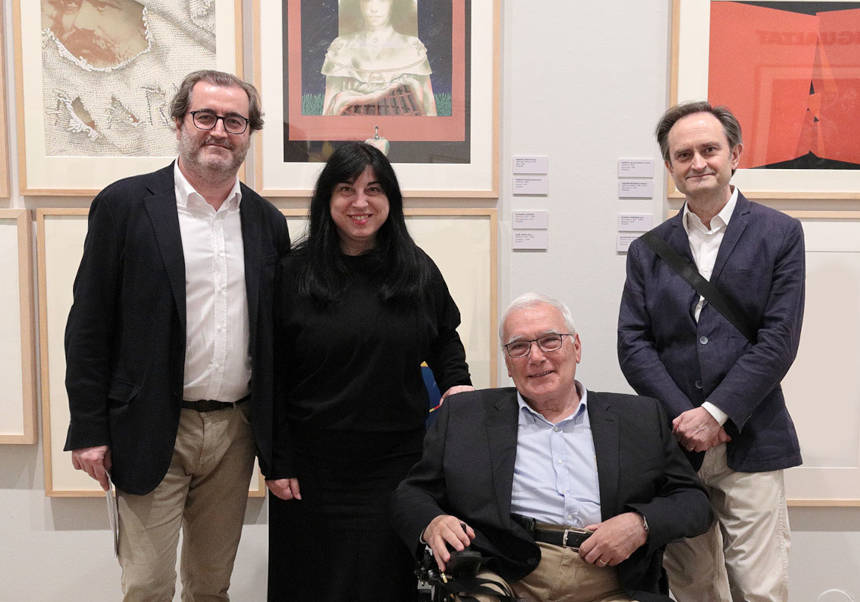
On Thursday 11 May, in the Martínez Guerricabeitia Hall in the Cultural Centre La Nau, the University of Valencia launched the exhibition ‘Estampas en transición’ (‘Prints in transition’). The exhibition, open until 3 of September, presents Martínez Guerricabeitia’s collection of graphic artworks. Valencia is the third city to host this ambitious exhibition project, which started last year in Algemesí and then moved on to Albaida.
In this edition, the exhibition consists of 130 works of graphic art created by a hundred different artists from the University of Valencia’s collection of contemporary art and is organized by Professor Felipe Jerez, curator and academic lead of the project.
The ample space in the Martínez Guerricabeitia Hall has allowed for a larger number of showcased artworks in comparison to the exhibitions in Algemesí (112) and Albaida (103).
Throughout the project, Professor Felipe Jerez has acknowledged “the effort” made so that ‘Estampas en transición’ “can truly showcase the richness and variety of the Martínez Guerricabeitia Collection, and it is not by accident that two thirds of the collection are prints that exemplify a wide variety of technique, style, and theme. He has grouped the works together with common elements of representation and a defining word for each of them, forming 17 sections that illustrate the interests, ideas, and feeling of both the collectors when acquiring the woks and the graphic art itself, created between the 1970s and the 1990s. These 17 defining words are: struggle, love, future, countryside, sex, tradition, reality, violence, nature, abstraction, death, power, geometry, portrait, politics, inequality, and repression.
“It’s an opportunity to enjoy for free the representative works of artists like Josep Renau, Manuela Ballester, Lichtenstein, Adami, Chillida, Teixidor, Tàpies, Saura, Anzo, Nassio, Yturralde, Arroyo, Vento, Horacio Silva, Richard Lindner, Rosa Torres, Carmen Calvo, Rafael Canogar, Juan Genovés, José Ortega, Antoni Miró, Agustín Ibarrola, José Luis Verdes, Equipo Crónica or Equipo Realidad,” says Professor Jerez. All of these works belong to the Martínez Guerricabeita Collection, one of the most important university collections of Spanish contemporary art, which is made up of almost half a thousand works and was bequeathed to the University of Valencia in 1999.
According to Professor Jerez, “The collection consists of works created in a variety of different techniques (woodcut, linocut, etching, aquatint, lithography and, mostly, silkscreen printing) in both colour and black and white. Some of the works are proofs, that is, the first attempts of the artist, and others are dedicated to their original owners: Jesús Martínez Guerricabeitia and Carmen García Merchante.”
The exhibition is organised by the Office of the Vice-Principal of Culture and Society at the University of Valencia, the General Foundation of the University of Valencia, and the Martínez Guerricabeita Collection with the collaboration of the City Council of Valencia.
The launch of the exhibition, this Thursday, saw the attendance of the vice-chancellor of Culture and Society, Ester Alba; the former director of the Martínez Guerricabeitia Collection and patron of the General Foundation of the UV, José Pedro Martínez; the Activities Director of the Collection, José Martín; and the curator, Felipe Jerez.
The vice-chancellor emphasised the itinerant character of the exhibition, a line of work of the office of the vice-principal that she directs in order to ensure that “university culture permeates these walls and integrates itself into society.” She went on to say, “The purpose of the University of Valencia is to convert culture into a democratic right equally accessible to everyone.”
José Pedro Martínez expressed that he was “impressed” when he saw more than a hundred works, many of them personalized, on display in the hall dedicated to his family. He further noted how the curator was able to articulate his principal idea of the exhibition through the concepts dedicated to such a diverse collection of artistic production.
The former director of the Collection, Jesús and Carmen’s son, recalled the personal relationship his parents had with the artists whose works make up the contemporary art collection now on display. “It’s such a pleasure to enjoy these works, many of them dedicated and/or acquired off-market, because they contain such personal content that clearly illustrates my father’s view on the purpose of the collection: to exercise patronage, not only economic, but also personal and intellectual, providing full support to contemporary artists,” he said.
Professor José Martin expressed that “both the works presented in this exhibition and its motivations share the desire to disperse art throughout society, beyond artistic circles, reaching more audiences outside of the habitual artistic consumers.” In fact, by producing multiple copies via engraving or silkscreen printing, the artists who created the works intended to make them more accessible to the public than paintings. Professor Martín concluded, “The University of Valencia now intends to share with the public an artistic collection that is characterised precisely by its social nature, a representation of a time when artists tried to address society as a whole.”
One of the very cultural objectives of the University is to preserve, enrich, study, and disperse its artistic patronage through projects that seek to bring art closer to society, thanks to the organisation of exhibitions inside and outside the city of Valencia.
Links:








